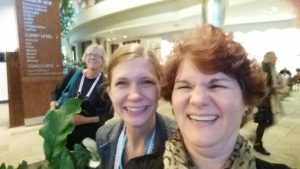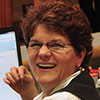This article is more than 5 years old.
My ALA Midwinter Experience was one part presenter, one part attendee and one part tourist. I was selected to do an Ignite session at this Midwinter, which is a 5 minute quick presentation with 20 slides that advance automatically. My topic was on our creation of the ZieSta Room in the library. I shared the stage with people who were telling their brief stories of introducing gaming in their public library after school program, finding grants to support a speaker series, and using (young) students to lead workshops and explorations on new technology. The room was packed, as the Ignite sessions frequently are. When I returned to that room on Sunday to see the next day’s Ignite offerings, the room was so full and spilling out into the hallway that I couldn’t get in to hear them. But, I understand that the sessions were all video recorded so hopefully, I can find them and view them soon.
On the attendee front, I listened with interest at a session that was led by Jason Griffey called “Measuring the Future“. He talked about his frustration with the current library practice of measuring the use of a library in ways that are not actionable. Just knowing how many feet came in your door or how many books circulated last year does not allow you to figure out what you can do to increase any of those things next year. With a grant from the Knight Foundation he created a Google Analytics style dashboard that allows one to follow library building usage, using “scouts” that upload to a “mothership” with cameras that track heat stamps in a way that ensures patron privacy. The hardware is open and the software is all open source. Once you know how people are actually using your library building, you can determine how you might change it to make it even better for users. His demonstration was very interesting. A future iteration of the system will also measure temperature, humidity and noise in a space. I hope we can join this movement!
I sat in on the Circulation Services Interest Group open discussion where there was some sharing of ways that we can use student assistants in new ways because physical circulation is declining. There was some more discussion of SUMA to track library usage. Penn State talked about their work in copyright clearing orphan works. In another library where Circulation and Reference have combined, they were discussing how they’d taken over Virtual Reference and were maintaining their Knowledge Base. More libraries have included Makerspaces in their suite of offerings and things like maintaining 3-D printers have been added to Circulation services, (yikes!). It was an interesting discussion to hear how Access Services departments are growing in different ways. Ultimately though, the conversation moved to who is charging overdue fees, and how effective are they, really. (It always ends this way.)
I attended the best ever Alexander Street Press breakfast with speakers Tamar Rogoff and Gregg Mozgala who are in the new film Enter the Faun. Ms. Rogoff is a choreographer who worked with Mr. Mozgala, an actor with cerebral palsy, to bring this dance to life. Her unusual teaching and training methods and study of movement have actually given the actor/dancer new control over his body and many of the limitations he’d learned to live with have diminished or disappeared. The pair have been bringing these new training techniques to students of physical therapy and their impact is expanding much beyond the world of dance.
On the tourist/networking end of things, I caught up with Lauren Pressley, visited the McFarland booth on the ALA vendor floor and took a picture next to the book I edited, enjoyed the ExLibris/Proquest night at the Boston Aquarium, and had an interesting view of history at the Boston Tea Party Museum.




3 Comments on ‘MBL’s ALA MW 16 in Boston’
I have to admit, I like the heat stamp tracking! It is interesting to think of other indicators of use besides head count! Thanks for sharing!
3D printing could go right next to the scanner, right? It is interesting to see how various institutions parse their services.
I agree with Hu, the heat stamp tracking sounds awesome! And having temp, humidity, and noise tracking would be fascinating. (Preview for 401: cold, low, and dirty-looks quiet.)